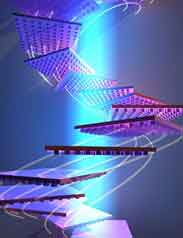The Sky’s Not the Limit for Light-Powered Travel
 Researchers at Caltech recently announced they have designed a way to levitate objects using only light. While the concept is still theoretical for now and is yet to be tested on actual physical objects, the work is a step toward developing a spacecraft that could travel outside our solar system powered and accelerated by only light.
Researchers at Caltech recently announced they have designed a way to levitate objects using only light. While the concept is still theoretical for now and is yet to be tested on actual physical objects, the work is a step toward developing a spacecraft that could travel outside our solar system powered and accelerated by only light.
The idea behind the method is that by creating specific nanoscale patterns on an object's surface, they will react with light so that the object can right itself when perturbed and create torque to keep it within the light beam. Thus, the object’s pattern would encode their own stability, even from a light source millions of miles away.
“There is an audaciously interesting application to use this technique as a means for propulsion of a new generation of spacecraft,” said Harry Atwater, professor of applied physics and materials science at Caltech. “We’re a long way from actually doing that, but we are in the process of testing out the principles.”
The research, funded by the Air Force Office of Scientific Research, could enable a spacecraft to be powered by an Earth-based laser light, reaching extremely high speeds without the need for fuel. Researchers behind the project believe a spacecraft patterned with the nanoscale structures could reach the nearest planet outside of our solar system within 20 years. Here on Earth, scientists envision the technology being used for rapid manufacturing of ever-smaller objects, like circuit boards.
Eye on Innovation is a monthly look at new technology, products, and trends.